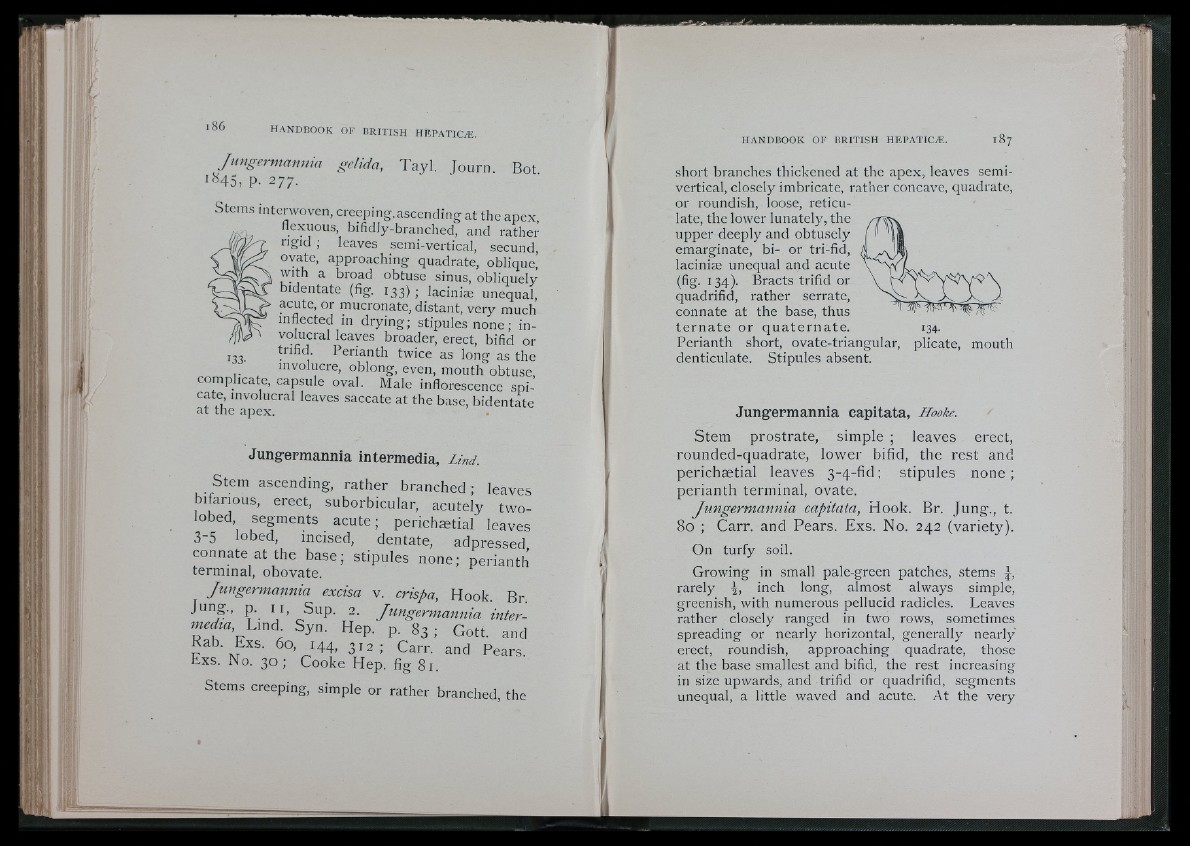
h a n d b o o k o f BRITISH HEPATICÆ.
Jungermannia gclida,
1845, P- 277.
Ta y l . Journ. Bot.
Stems interwoven, creeping.asccnding at the apex,
flexuous, bifidly-branched, and rather
rigid ; leaves semi-vertical, secund
ovate, approaching quadrate, oblique!
with a broad obtuse sinus, obliquely
bidentate (fig. 133) ; laciniæ unequal,
acute, or mucronate, distant, very much
inflected in drying; stipules none ; involucral
leaves broader, erect, bifid or
trifid. Perianth twice as long as the
involucre, oblong, even, mouth obtuse,
capsule oval. Male inflorescence spicate,
133-
complicate,
involucral leaves saccate at the base, bidentate
at the apex.
Jungermannia intermedia, Lind.
Stem ascending, rather branched; leaves
bifarious, erect, suborbicular, acutely two-
lobed, segments a cute ; perichæt ial leaves
3-5 lobed, incised, dentate, adpressed
connate at the base; stipules none; perianth
terminal, obovate.
Jimgermannia excisa v. crispa, Hook. Br.
Jung., p. I I , Sup. 2. Jungermannia inter-
medm U nA Syn. Hep. p. 8 3 ; Gott. and
Rab. Exs. 60, 144, 3 , 2 ; Carr, and Pears
Exs. No. 3 0 ; Co o ke Hep. fig 8i .
Stems creeping, simple or rather branched, the
HANDBOOK OF BRITISH HEPATICÆ.
short branches thickened at the apex, leaves semi-
vertical, closely imbricate, rather concave, quadrate,
or roundish, loose, reticulate,
the lower lunately, the
upper deeply and obtusely
emarginate, bi- or tri-fid,
laciniæ unequal and acute
(fig. 134). Bracts trifid or
quadrifid, rather serrate,
connate at the base, thus
te rn a te or q u a te rn a te .
Perianth short, ovate-triangular, plicate, mouth
denticulate. Stipules absent.
Jungermannia capitata, Llooke.
S tem prostrate, simple ; leaves erect,
rounded-quadrate, lowe r bifid, the rest and
perichæt ial leaves 3-4-fid: st ipules n o n e ;
perianth terminal, ovate.
Jungermannia capitata. Hook. Br. Jung., t.
80 ; Carr, and Pears. Exs. No. 242 (variety).
On turfy soil.
Growing in small pale-green patches, stems J,
rarely' inch long, almost always simple,
greenish, with numerous pellucid radicles. Leaves
rather closely ranged in two rows, sometimes
spreading or nearly horizontal, generally nearly
erect, roundish, approaching quadrate, those
at the base smallest and bifid, the rest increasing
in size upwards, and trifid or quadrifid, segments
unequal, a little waved and acute. At the very
Í ita